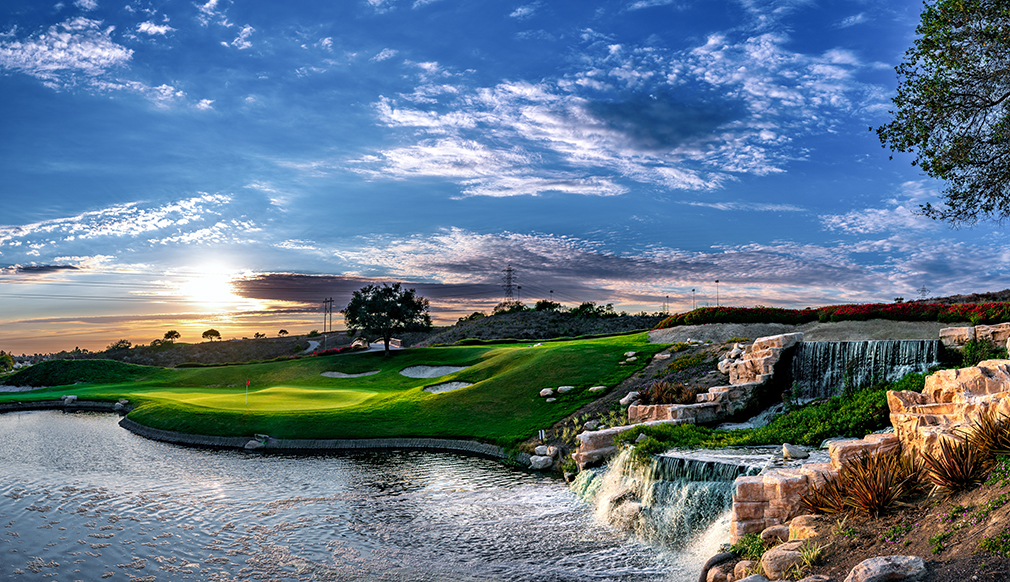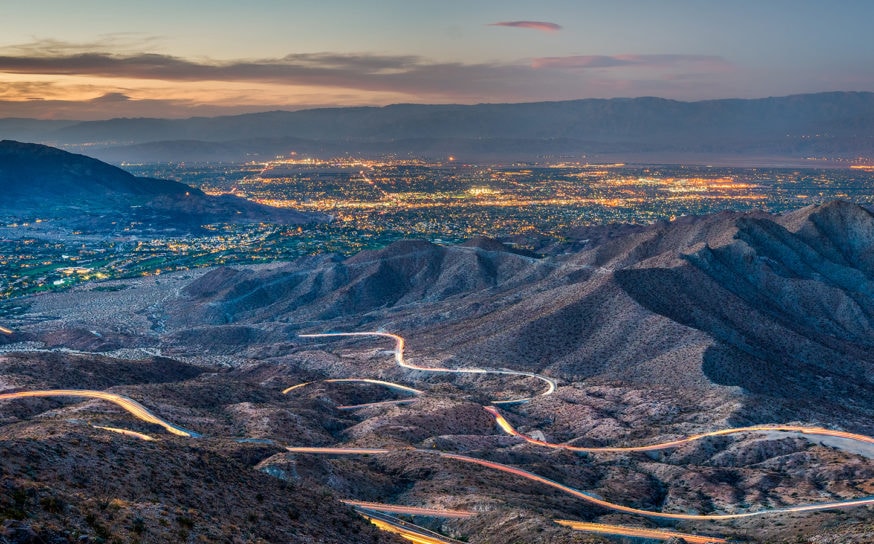This Trio of Carlsbad Golf Courses Deserves a Closer Look
Tee it up in sunny SoCal.
-
CategoryExperiences, Life Outside
-
Written byShaun Tolson
Each year around this time, the PGA Tour makes its swing through Southern California; and as the world’s best players tee it up at Torrey Pines, San Diego’s top-shelf public golf course enjoys its annual 15 minutes in the spotlight. The municipal golf club, which has hosted two U.S. Opens in the past 15 years, isn’t the only championship-caliber golf course in the area, however. Equally exceptional golf facilities exist only a short, 20-minute drive away.
For decades, many of the sport’s leading equipment manufacturers have operated out of headquarters located in Carlsbad, a coastal city home to about 115,000 people; yet, the metropolis is still a hidden gem for golf trips, at least according to one course executive. “If you were to survey people about what they’re going to do when they come to Carlsbad, their answer would be more about the beaches and the hiking and the great food,” says Tate Stull, the general manager of The Crossings at Carlsbad—a municipal golf course that opened for play in 2007. “Golf is still a bit of an unknown here, unless you’re talking about Torrey [Pines]. Most people come [to greater San Diego] for Torrey.”
If you’re contemplating a trip south for golf, memorable rounds await at a handful of courses beyond the region’s most famous club. Here, we spotlight three of the best.

Adventurous Pursuits
At The Crossings at Carlsbad, it won’t take long for golfers to understand why the city of Carlsbad is famous for its hiking trails. The opening hole, a 447-yard par four, plunges downhill to a broad, well-contoured green. About 500 yards away from that opening hole’s putting surface, the fairway of the second climbs another rolling hill, cresting about 260 yards from the back tee boxes and offering players a slight downhill approach shot to a green well protected by an expansive bunker to the right and mogul-like slopes to the left. By the time golfers reach the fifth green, they will have already traveled at least a mile and a half.
If you notice a pattern developing, it’s for good reason. Sprawling might be the word that best describes this layout, as the course meanders across 400 acres, its 18 holes strung together by seven and a half miles of cart paths. Just as is the case on many of the surrounding hillsides, it’s a hike getting around The Crossings, which is why golf carts are mandatory. As for its name, the course’s moniker reflects the handful of bridges that allow golfers to traverse creeks and protected natural areas, the latter of which almost prevented the course from being built.
Initial routing plans were drafted by architect Greg Nash in the late 1980s, but the site was home to vast expanses of conservation land. Not surprisingly, those ecologically sensitive areas buried the development in mounds of red tape. Eventually, all of the necessary zoning permits were acquired, but the judicial process with the city was a long and arduous one. When the course finally opened for play, almost twenty years had passed. Concurrently, upwards of $70 million had been spent to construct all of the course’s infrastructure (including the clubhouse, restaurant spaces, and other amenities).
Given the strict regulations that were in place for how and where the golf course could be built, many of the resulting holes have a natural aesthetic. “We were utilizing the terrain that we had, cutting holes out of what was provided,” Stull explains. “That created some unique holes. Because of that, The Crossings has more of a natural vibe versus something that was manufactured.”
In particular, Stull points to multiple holes on the back nine, which are tucked tightly between hillsides. Some fairways also sit precariously on ridgelines with densely vegetated, scrub-covered embankments falling steeply away to the canyon floor hundreds of feet below. For that reason, golfers must execute proper course management—which includes playing from the appropriate tee boxes—if they’re going to enjoy their rounds at The Crossings. “You really have to think your way around the golf course,” Stull says. “The front nine gives you some time to think about it and to know where you’re going, but by the time you get to hole number 10, you better be dialed in. There will be some shots that you face that you might not have to hit at most golf courses.
“All of a sudden things get a bit more interesting,” he adds with a laugh, “especially if you haven’t played here before.”

The King’s Playground
Nestled into a trio of valleys and meandering across 180 acres, the 7,007-yard layout at Aviara Golf Club is the only Arnold Palmer-designed golf course in San Diego County. The course opened for play in 1991, but similar to The Crossings, the project was in the works for a long time prior to that. Just like the aforementioned municipal course, environmental concerns and the necessary protection of several wildlife areas delayed Aviara Golf Club’s completion for about a decade.
When all was said and done, the resulting course rambled over rolling terrain, delivering about 500 feet of total elevation change. According to the club’s director of golf, Renny Brown, the course hasn’t changed much in that time, aside from many trees reaching full maturity.
Those who are familiar with Palmer’s work as a course designer are certain to spot characteristics that reflect The King’s architectural style. Most notably, Aviara is defined by wide, generous landing areas, large bunkers, equally large greens, and gradual undulations across the terrain. “Even if you’ve never played here before you can feel comfortable off the tee,” Brown says, “because what you see is what you get. Definitely spend some time on the putting green, though, because the greens here are the challenge.”
Yes, Aviara features several prominent water hazards that are in play on half of the holes, and those penal areas are certain to affect the average golfer; however, it’s the green complexes—the significantly contoured putting surfaces, specifically—that make the golf course an ideal venue for championship golf. Partially for that reason, Aviara has hosted an annual LPGA event for the better part of a decade. “For the better player, the greens are the defense of the golf course,” says Brown. “They’re very large with a lot of slope and undulation. It’s about more than just hitting it on the green. [To score], it’s about hitting it in the right spot.”
More so than other nearby golf courses, Aviara is surrounded by an abundance of flora that is in bloom for much of the year. For that reason, a round there has often been described as “golf within a botanical garden.” In particular, the par-3 14th hole is Brown’s favorite, since much of the area around the tee boxes stair-stepping their way down toward a small lagoon is planted with wildflowers. “She’s the show pony,” Brown says. “But we probably have at least five holes that any golf course in America would consider to be their signature hole.”

Return to Greatness
Signature holes are yet to be defined on the Champions Course at La Costa Resort, only because architect Gil Hanse and his partner Jim Wagner just recently broke ground on a major renovation that will tweak every hole on the course—some significantly—ahead of the resort hosting the first of three consecutive NCAA Division 1 Women’s and Men’s Championships, beginning in 2024. Major championship golf being played at La Costa doesn’t represent a new chapter for the 400-acre resort. Instead, it delineates a return to the property’s heritage.
When Dick Wilson designed and built the resort’s original golf course in 1965—a project that cost $1.5 million at the time (the equivalent of almost $14 million today)—the layout was created, at least in part, to host the CBS Golf Classic, a premier exhibition event that attracted the biggest names in golf. A few years later, the course hosted the PGA Tour’s Tournament of Champions, an exclusive invitational event that returned annually to La Costa for the next three decades.
Eventually, the Tournament of Champions relocated to Kapalua Resort in Hawaii, and over the subsequent two-plus decades, La Costa’s flagship golf course grew tired. If the resort wanted to bring back significant championship events, it needed to update its golf course. In the minds of the property’s lead decision makers, there was no better architect for the job than Hanse, who recently renovated the North Course at Los Angeles Country Club in preparation for this year’s U.S. Open. “We’ve got the best designer on the planet doing our golf course,” says Dustin Irwin, La Costa’s director of golf. “We’re getting back into a major golf championship, and for me that’s really exciting. It’s elevating La Costa back to the upper echelon of the golf world.
“This project is so impactful for the future of the entire property,” he continues. “Pre-renovation, we were a beautiful resort that had good golf. But post-renovation, La Costa becomes a golf destination with incredible amenities. It becomes the complete package.”
Although it’s difficult for Irwin to place his finger on a singular aspect of the project that most excites him; when pressed, he focuses on Hanse’s commitment to bring the look and feel of the surrounding landscape onto the golf course. As Irwin explains, Hanse found part of his inspiration by studying the ways that the golf courses at Riviera Country Club and the Valley Club of Montecito embraced and reflected their SoCal environments. According to the course architect, creating a similar aesthetic at La Costa is a prominent aspect of the project.
“The setting and surrounds of the Champions Course [at La Costa] lend themselves to a golf experience that looks and feels authentic to Southern California,” Hanse says. “I’m hopeful that when we’re done we’ll create holes that you’ve never seen before and in a landscape that’s distinctive enough so that people will really appreciate those changes.”
Beyond the immediate task at hand, which includes creating a resort amenity that can easily transform into a compelling championship venue, Hanse is most excited about the prospect of furthering the site’s legacy as a stage for world-class golf. “Growing up on the East Coast and watching the tournaments here and seeing the best players in the world play here, that resonates with me,” Hanse says. “The magnitude and significance of that is not lost on Jim [Wagner] or myself; and if we do our job, that history is going to be resurrected.”
The Best California Wines to Pour at Your Thanksgiving Meal
From our seasoned sommelier to your table.
Coachella Awarded $500,000 Cannabis Grant
The city, not the festival, is the latest location to receive money from the Bureau of Cannabis Control.
Get the Latest Stories





